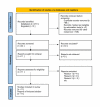Role of Metformin in the Management of Polycystic Ovarian Syndrome-Associated Acne: A Systematic Review
- PMID: 36176868
- PMCID: PMC9511677
- DOI: 10.7759/cureus.28462
Role of Metformin in the Management of Polycystic Ovarian Syndrome-Associated Acne: A Systematic Review
Abstract
Metformin, a biguanide hypoglycemic agent that is safe and effective for treating acne in women with the polycystic ovarian syndrome (PCOS), has shown growing evidence of improving insulin resistance, hyperandrogenism, dyslipidemia, overall cardiovascular health, quality of life, psychological wellbeing, and general health outcomes. This study aims to identify and summarize the effects of metformin in patients with PCOS-associated acne. This systematic review was based on the Preferred Reporting Items for Systematic Reviews and Meta-Analyses (PRISMA) guidelines. A systematic search was done on PubMed, PubMed Central, Cochrane, Google Scholar, and Science Direct databases from 2011 up to 23 February 2022. Randomized controlled trials (RCTs), cross-sectional studies, observational studies, literature reviews, systematic reviews, and meta-analyses published in English were selected. The data was extracted to a predefined template. Each study was individually checked by using a quality assessment. The initial search generated a total of 218 studies. Nine studies were included in the final selection: two RCTs, one hospital-based longitudinal study, one hospital-based clinical trial, three cross-sectional studies, three systematic reviews with meta-analyses, and one narrative review. Metformin is generally effective and safe for improving PCOS-associated acne and the quality of life. More clinical trials are required to determine the indications for prescribing metformin in patients with PCOS-associated acne.
Keywords: acne; antiandrogen; hyperandrogenism; metformin; nodulocystic acne; polycystic ovarian syndrome.
Copyright © 2022, Shamim et al.
Conflict of interest statement
The authors have declared that no competing interests exist.
Figures
References
-
- Amenorrhea associated with bilateral polycystic ovaries. Stein IF. https://www.sciencedirect.com/science/article/abs/pii/S0002937815306426 Am J Obstet Gynecol. 1935:181–191.
-
- Preliminary indication of a high prevalence of polycystic ovary syndrome in indigenous Australian women. Davis SR, Knight S, White V, Claridge C, Davis BJ, Bell R. https://www.tandfonline.com/doi/abs/10.1080/gye.16.6.443.446. Gynecol Endocrinol. 2002;16:443–446. - PubMed
-
- Clinical manifestations and insulin resistance (IR) in polycystic ovary syndrome (PCOS) among South Asians and Caucasians: is there a difference? Wijeyaratne CN, Balen AH, Barth JH, Belchetz PE. Clin Endocrinol (Oxf) 2002;57:343–350. - PubMed
-
- Polycystic ovaries and associated metabolic abnormalities in Indian subcontinent Asian women. Rodin DA, Bano G, Bland JM, Taylor K, Nussey SS. Clin Endocrinol (Oxf) 1998;49:91–99. - PubMed
Publication types
LinkOut - more resources
Full Text Sources



